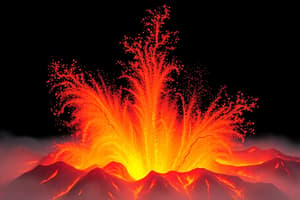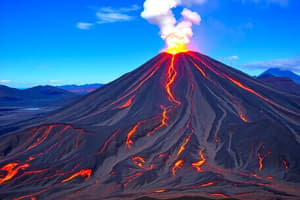Podcast
Questions and Answers
Which type of volcano is most likely to have a long, broad, sloping shape?
Which type of volcano is most likely to have a long, broad, sloping shape?
- Cinder
- Shield (correct)
- Composite
- Dormant
Which of the following is NOT a factor that influences weather?
Which of the following is NOT a factor that influences weather?
- Humidity (correct)
- Ocean Current
- Latitude
- Wind/Air Pressure
How does the elevation/altitude affect the temperature?
How does the elevation/altitude affect the temperature?
- Lower elevation leads to warmer temperatures. (correct)
- Higher elevation leads to warmer temperatures.
- Higher elevation has no effect on temperature.
- Higher and lower elevation both affect temperatures.
What is a 'parasitic cone'?
What is a 'parasitic cone'?
Which of the following eruptions is characterized by the contact between water and magma?
Which of the following eruptions is characterized by the contact between water and magma?
What is the effect of relief on rainfall?
What is the effect of relief on rainfall?
Which type of volcano is known for its violent eruptions and the production of pyroclastic materials?
Which type of volcano is known for its violent eruptions and the production of pyroclastic materials?
How is the temperature of water utilized for heating buildings?
How is the temperature of water utilized for heating buildings?
What type of volcanic hazard is a fast-moving cloud of hot ash and poisonous gases?
What type of volcanic hazard is a fast-moving cloud of hot ash and poisonous gases?
What is the difference between weather and climate change?
What is the difference between weather and climate change?
What is the main difference between an inactive and an extinct volcano?
What is the main difference between an inactive and an extinct volcano?
Which of these is NOT a disadvantage of volcanic activity?
Which of these is NOT a disadvantage of volcanic activity?
What is the name given to the fertile soil created by volcanic activity?
What is the name given to the fertile soil created by volcanic activity?
What is a characteristic of Plinian eruptions?
What is a characteristic of Plinian eruptions?
What is the main cause of ground swells, ground tilt, and fissuring before a volcanic eruption?
What is the main cause of ground swells, ground tilt, and fissuring before a volcanic eruption?
What are the two main sources of geothermal energy?
What are the two main sources of geothermal energy?
How does a geothermal power plant generate electricity?
How does a geothermal power plant generate electricity?
What are some of the potential negative effects of volcanic eruptions?
What are some of the potential negative effects of volcanic eruptions?
Which of the following is NOT a natural factor that contributes to climate change?
Which of the following is NOT a natural factor that contributes to climate change?
What are some of the advantages of using geothermal energy?
What are some of the advantages of using geothermal energy?
What is the scientific name for heat within the earth?
What is the scientific name for heat within the earth?
What is the fourth state of matter?
What is the fourth state of matter?
What happens to the trade winds during an El Nino event?
What happens to the trade winds during an El Nino event?
What does the constellation Gemini signify for Filipino farmers?
What does the constellation Gemini signify for Filipino farmers?
What factor affects the apparent brightness of a star?
What factor affects the apparent brightness of a star?
What is the difference between a star's luminosity and apparent brightness?
What is the difference between a star's luminosity and apparent brightness?
What color are the coolest stars?
What color are the coolest stars?
What is the difference between a constellation and an asterism?
What is the difference between a constellation and an asterism?
What is the apparent motion of stars in the night sky?
What is the apparent motion of stars in the night sky?
What is the Kelvin scale used to measure?
What is the Kelvin scale used to measure?
What constellation signifies that it is time for Manobos to start planting?
What constellation signifies that it is time for Manobos to start planting?
Flashcards
Heat Pump System
Heat Pump System
Transfers heat by pumping water or refrigerant through pipes.
Climate Change
Climate Change
Significant, long-term changes in temperature and weather patterns.
Weather
Weather
Temporary atmospheric conditions influenced by various factors.
Latitude
Latitude
Signup and view all the flashcards
Elevation
Elevation
Signup and view all the flashcards
Effects of Volcanic Eruptions
Effects of Volcanic Eruptions
Signup and view all the flashcards
Fertile Soil from Volcanoes
Fertile Soil from Volcanoes
Signup and view all the flashcards
Geothermal Energy
Geothermal Energy
Signup and view all the flashcards
Signs of Imminent Eruptions
Signs of Imminent Eruptions
Signup and view all the flashcards
Sources of Geothermal Energy
Sources of Geothermal Energy
Signup and view all the flashcards
Volcanic Eruptions and Climate Change
Volcanic Eruptions and Climate Change
Signup and view all the flashcards
Geothermal Power Plant Process
Geothermal Power Plant Process
Signup and view all the flashcards
Advantages of Volcanoes
Advantages of Volcanoes
Signup and view all the flashcards
Volcano
Volcano
Signup and view all the flashcards
Parts of a Volcano
Parts of a Volcano
Signup and view all the flashcards
Active Volcano
Active Volcano
Signup and view all the flashcards
Dormant Volcano
Dormant Volcano
Signup and view all the flashcards
Shield Volcano
Shield Volcano
Signup and view all the flashcards
Composite Volcano
Composite Volcano
Signup and view all the flashcards
Phreatomagmatic Eruption
Phreatomagmatic Eruption
Signup and view all the flashcards
Lahar
Lahar
Signup and view all the flashcards
El Niño
El Niño
Signup and view all the flashcards
La Niña
La Niña
Signup and view all the flashcards
Stars
Stars
Signup and view all the flashcards
Luminosity
Luminosity
Signup and view all the flashcards
Apparent Brightness
Apparent Brightness
Signup and view all the flashcards
Surface Temperature of Stars
Surface Temperature of Stars
Signup and view all the flashcards
Constellation
Constellation
Signup and view all the flashcards
Asterism
Asterism
Signup and view all the flashcards
Apparent Motion
Apparent Motion
Signup and view all the flashcards
Mass of Stars
Mass of Stars
Signup and view all the flashcards
Study Notes
Volcanoes
- Volcanoes vary in height, shape, and slope, related to their magma composition.
- A volcano is an opening in the Earth's surface where molten rock, smoke, gases, and ashes erupt.
- Volcano parts include a main vent, parasitic cone, side vent, magma chamber, and volcanic ash.
Volcano Classification
- Active: Erupted within the last 600 years or 10,000 years ago.
- Inactive: Not erupted in the last 10,000 years.
- Dormant: Hasn't erupted for a long time, but might in the future.
- Extinct: Hasn't erupted for at least 100,000 years.
Volcano Types
- Shield Volcanoes: Broad, gently sloping sides, made of thin, runny basaltic lava, formed over hotspots, and have many vents. They erupt gently.
- Composite Volcanoes: Steep, made of layers of ash, tephra, and thick, sticky lava (andesitic). Erupt violently and have little lava flow, more pyroclastic material.
- Cinder Cones: Small, steep volcanoes made of volcanic debris that builds up around a vent. Erupt violently and are the most common and smallest type. They don't generally have vents. All are explosive volcanoes.
Types of Eruptions
- Phreatic/Hydrothermal: Steam driven, caused by hot rocks' contact with water, producing ash columns.
- Phreatomagmatic: From the contact of water and magma. Produces large ash columns and pyroclastic base surges.
- Strombolian: Weak to violent eruptions, fountain lava.
- Vulcanian: Tall eruption columns reaching 20 km high, lasting seconds to minutes.
- Plinian: Explosive eruptions with high rates of magma discharge, lasting minutes to hours. The largest eruptions that occur.
Importance of Volcanoes
- Disadvantages:
- Lahars (mudflows).
- Pyroclastic flows (glowing avalanches).
- Damage to property.
- Effects on the environment (climate change).
- Loss of life.
- Advantages:
- Fertile soil.
- Tourism.
- Creation of new land.
- Building materials.
- Geothermal energy.
Signs of Volcanic Eruptions
- Increased tremors.
- Increased steaming activity.
- Crater glows.
- Ground swells, ground tilt, and fissuring (magma intrusion).
- Localized landslides, rock falls, and landslides.
- Increase in temperature of hot springs.
- Noticeable variations in chemical content of springs.
- Drying up of springs.
- Development of new thermal areas.
Climate Change and Weather
- Weather: Short-term, fluctuating conditions influenced by various factors.
- Factors: Latitude, ocean currents, wind and air pressure, elevation/altitude, and relief.
- Important Elements: Temperature, humidity, rainfall, seasons, climate.
- El Niño & La Niña: Associated with warmer (El Niño) or colder (La Niña) water temperatures. El Niño can lead to heavy rains, and La Niña to dry conditions.
Stars
- Plasma: Fourth state of matter, ionized gas where electrons are ripped away. Stars are made of plasma.
- Brightness: Luminosity (total amount of light) versus apparent brightness (perceived from earth), depending on distance, affecting how we see stars in the night sky.
- Color: Depends on surface temperature of a star. Cooler = redder; hotter = bluer or whiter.
- Size & Mass: Stars are measured in comparison to our Sun, relative to the size and mass of our star.
- Constellations & Asterisms Patterns of stars. Asterisms are smaller groups/patterns within constellations. Helpful for navigation and relating to seasons and agricultural methods.
Studying That Suits You
Use AI to generate personalized quizzes and flashcards to suit your learning preferences.




